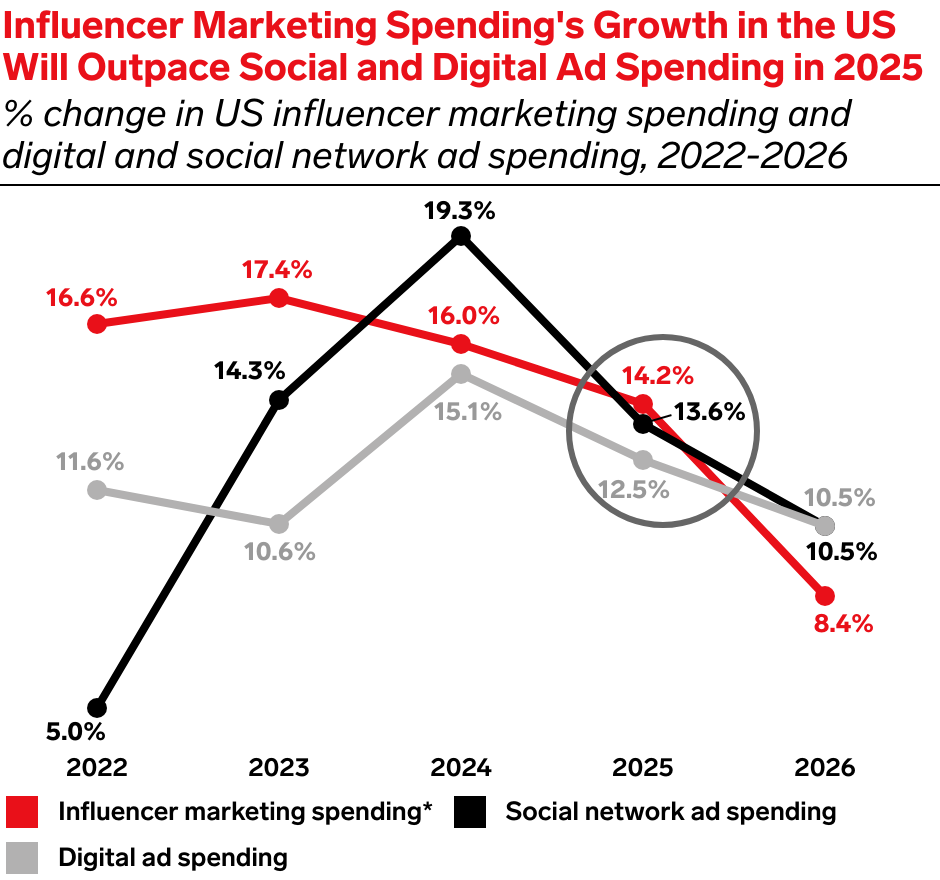How Contextual Commerce Media Complements Influencer Marketing
By Caroline Zerilli, Product Marketing Manager at Chicory
When Unilever recently announced plans to allocate 50% of its social media budget toward influencer partnerships, it signaled more than just a shift in spending—it confirmed what many marketers have observed: authentic connections are now essential currency in digital advertising.
The trust consumers place in creators has fundamentally changed how brands communicate. 86% of US marketers are now dedicating budget to influencer marketing. According to eMarketer’s latest forecast, U.S. sponsored content spending will surpass $10 billion in 2025—and is growing faster than both social network ad spending (10.5%) and overall digital ad spending (12.5%), reflecting brands’ strategic shift toward authentic creator-driven connections.
Yet as influencer marketing matures, brands face new challenges in scaling these authentic connections while maintaining measurable impact. This is where contextual commerce media emerges—not as a replacement, but as a natural extension of influencer strategies.
Influencer Marketing’s Growing Pains
The appeal of influencer marketing is clear. Consumers increasingly trust authentic creator voices over traditional brand messaging, with 69% of consumers reporting that they trust influencers, friends, and family over direct brand communications. This authenticity drives engagement in ways traditional advertising cannot.
Industry trends continue to reflect this emphasis on authentic connection, with eMarketer projecting that U.S. nano-influencer spend will grow by 36.2% YoY in 2025, faster than any other tier, followed by micro-influencer spend at 25.3% growth. In many ways, growth in these categories signals a return to the roots of word-of-mouth marketing.
However, as brands deepen their creator investments, key challenges emerge:
Scale and measurement complexity: Maintaining consistent messaging across thousands of creator relationships requires significant resources.
Measurement limitations: While influencer platforms offer strong engagement metrics, attribution remains challenging, with limited visibility into true sales impact and ROI. This is a widespread concern across the industry, with research from Linqia showing that 60% of enterprise marketers cite determining influencer campaigns’ ROI as their top challenge.
Path to purchase friction: When consumers discover products through influencers, they might need to take multiple steps to complete a purchase—searching for the product, comparing options, and navigating to a retailer’s site. This friction between inspiration and action can result in drop-off in the consumer journey.
Where Contextual Commerce Media Fits In
Like influencer marketing, contextual commerce media thrives by integrating brand messaging within content consumers actively seek out. The key difference lies in its ability to reach consumers during high-intent moments—when they’re actively planning purchases, not passively scrolling.
What makes contextual commerce media such a powerful complement to influencer strategies:
Non-intrusive presence: Similar to influencer content, contextual commerce media fits naturally into the fabric of people’s daily lives. Rather than interrupting experiences, it enhances them by appearing within content consumers are already engaged with.
“Authentic” content network: By activating content across premium publishers and independent bloggers, contextual commerce offers scale across trusted content creators with an established audience—extending the authentic connection influencers initiate.
Contextual relevance: Products appear precisely when consumers are most receptive—while browsing recipes, planning meals, and seeking inspiration. Reaching shoppers in this mindset is critical, as 80% of consumers have been inspired by a recipe to purchase a new product.
Measurable results: With clear attribution and closed-loop measurement capabilities via third-party and retail media network partnerships, brands gain visibility into actual purchase behavior. Typical campaign executions consistently deliver average incremental ROAS of 3.0X with 40% of purchases coming from new or lapsed shoppers.
Creating a Seamless Consumer Journey, Together
When deployed together, influencer marketing and contextual commerce media create a clear consumer journey:
Bridging the gap: While influencer strategies excel at driving initial discovery and desire, contextual commerce media provides additional touchpoints at critical decision-making moments in the mid-funnel phase.
Extending brand presence: Maintains visibility beyond the initial influencer touchpoint, ensuring brands remain top-of-mind when purchase decisions are made.
Completing the marketing funnel: Improves overall marketing effectiveness by capturing consumers throughout their purchase journey—from initial discovery through recipe research to the retailer’s cart.
Consider a consumer who discovers a new high-protein pasta from their favorite food creator. The initial awareness is valuable, but what happens two weeks later when they’re searching for dinner ideas? By maintaining presence within online recipe content through contextual commerce media, that same brand can reappear when the consumer is planning their shopping list—transforming earlier inspiration into action.
Authenticity Across the Path to Purchase
As consumers' expectations evolve, successful brands are recognizing that authentic connections must extend beyond social media feeds into the practical moments of daily life. By leveraging the complementary strengths of influencer and contextual commerce, brands can create a cohesive marketing strategy that respects how people actually discover and shop for products.
The brands winning consumer loyalty today understand that the path from inspiration to purchase is rarely linear. By meeting consumers with authentic messaging at every stage of their journey, these brands aren’t just influencing decisions—they’re becoming integrated into consumers’ lives.
Want to learn more about how contextual commerce can extend your influencer strategy? Say hello@chicory.co to discover how leading CPG brands and retailers are partnering with Chicory.











